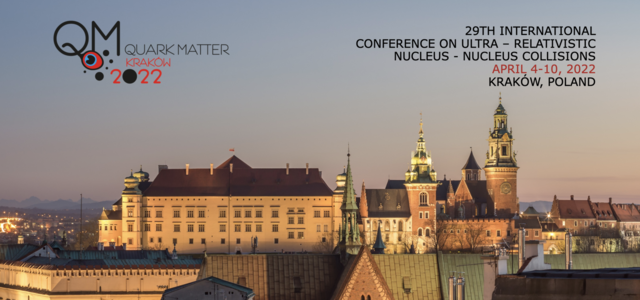
The ALICE Collaboration reports a wide range of new physics results at the International Conference on Ultrarelativistic Nucleus-Nucleus Collisions (Quark Matter 2022) this week (4-10 April 2022). The status of the upgraded detector commissioning for the LHC Run 3, prospects for further upgrades for Run 4, and the completely new heavy-ion detector ALICE 3 for Run 5 and beyond are also presented. The ALICE Collaboration participates in Quark Matter 2022 with 1 plenary, 35 parallel and 94 poster presenters. The plenary presentation on 5 April reports the highlights of new ALICE measurements. A selection of physics results is presented in the following sections.
Pushing the boundaries of large-radius low-energy jets in Pb-Pb collisions
Jets are sprays of collimated hadrons that result from the fragmentation of energetic quarks or gluons produced in hard scattering processes. In presence of a quark-gluon plasma, as formed in high-energy nucleus-nucleus collisions, the interaction of the quarks and gluons as they traverse this medium causes jet quenching: the measured yields of jets are reduced with respect to the expectation from proton-proton collisions. This reduction is quantified in terms of a reduction of the nuclear modification factor RAA with respect to the expected value of unity. A possible explanation for jet quenching is additional medium-induced radiation of gluons at large angles with respect to the jet direction. ALICE provides important new insight to this study by measuring RAA of low-energy jets, which are most affected by jet quenching, for large values of the jet resolution parameter (connected to the area covered by the jet in the detector acceptance). This is achieved by coupling the detector capabilities to recover low-energy jet particles and a machine-learning approach to subtract the jet-unrelated particles from the underlying Pb-Pb collision. The preliminary results show that large-radius charged-particle jets with radius (R) of 0.6 are slightly more quenched than narrower jets down to an energy of 40 GeV. This suggests that radiated energy is not recovered even in this larger area and that wider jets with a more complex substructure may lose more energy or become narrower when crossing the QGP.
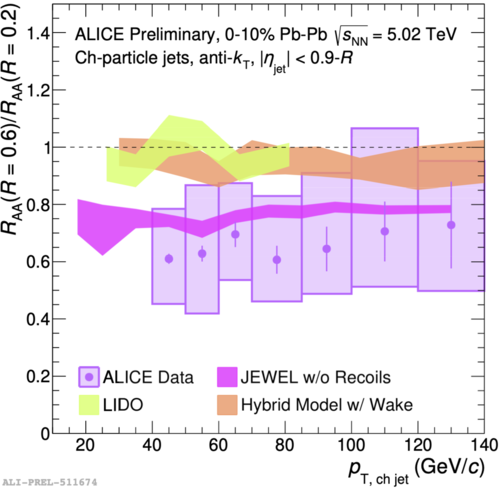
Ratio of the nuclear modification factors RAA of jets with R=0.6 and jets with R=0.2 in central Pb-Pb collisions, compared with jet quenching calculations.
Further information: http://alice-figure.web.cern.ch/node/15723
Charm-quark diffusion in the quark-gluon plasma
In heavy-ion collisions charm quarks are produced in initial hard scattering processes and they subsequently cross the quark-gluon plasma (QGP). The interactions with the quarks and gluons of the QGP lead to both a reduction of the charm-quark energy (energy loss) and deflections of their propagation directions. The latter can be described in analogy to diffusion of particles in a dense fluid. Measurements of prompt D mesons (that contain a charm and a light quark) are sensitive to some of the properties of the QGP, including the charm-quark diffusion coefficient. The measurements performed with the data sample of Pb-Pb collisions at 5.02 TeV collected with the ALICE detector in 2018 allowed us to constrain the spatial diffusion coefficient of charm quarks in the QGP via a quantitative comparison of the nuclear modification factor RAA, the elliptic and triangular flow coefficients with theoretical models. The estimated range for the spatial diffusion coefficient is 1.5 < 2πDsTc < 4.5 at the critical temperature for the QGP phase transition, Tc = 155 MeV, and it is substantially narrower with respect to previous publications.

Nuclear modification factor of charm D mesons compared with theoretical models implementing charm-quark transport in the QGP, and charm-quark diffusion coefficient (dark red band) compared to previous estimations and to lattice QCD calculations (lQCD).
Further reading: arXiv:2110.09420
Charmonium as gyroscope
Spin is an intrinsic angular momentum carried by elementary particles. Its alignment with respect to a given axis is called polarisation. During the initial stages of ultrarelativistic heavy-ion collisions, extremely strong electromagnetic fields are produced by the fast moving colliding nuclei. In semi-central collisions, the produced magnetic field may exceed 1020 Gauss and is oriented perpendicularly to the reaction plane formed by the nuclei impact parameter and the beam axis. Just like a gyroscope in the Earth’s gravitational field, the spin of particles produced in the collisions can align along the direction of the magnetic field. In addition to this, the formation of the quark-gluon plasma (QGP) can induce additional spin alignment, since the QGP behaves like a fluid with an extremely large vorticity up to 1022 rotations per second perpendicular to the reaction plane.
The J/ψ meson is a bound state of charm and anticharm quarks, which has a spin quantum number of 1. Due to their large mass, the charm and anticharm quarks are created during the initial stages of the collisions, thus making the J/ψ a perfect probe to study the polarisation phenomena. ALICE presents a first measurement of J/ψ polarisation with respect to the reaction plane in Pb-Pb collisions. The results show a small but significant spin alignment along the axis perpendicular to the reaction plane and shed more light on the role of the strong magnetic field generated in these collisions as well as the properties of the fastly rotating QGP fluid.
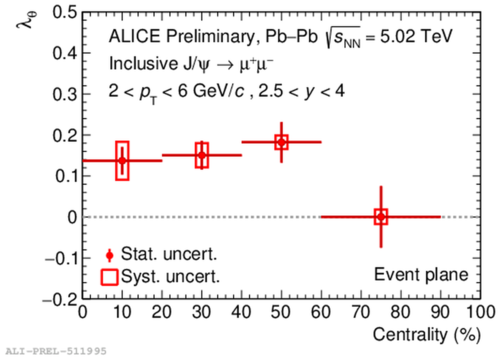
Strength of the J/ψ polarisation as a function of the collision centrality.
Further reading: ALICE-PUBLIC-2022-005 <http://cds.cern.ch/record/2805485>
The antimatter-to-matter asymmetry in the little bang
The Universe contains only 5.4x10-10 baryons per photon. This ratio is so small, because almost all the matter particles annihilated with antimatter particles a few instants after the Big Bang. Pb-Pb collisions at the LHC create conditions similar to those of the early Universe. In such collisions, however, a much larger excess of matter with respect to antimatter is observed, because the initially-colliding nuclei are made of matter particles. ALICE measurements show about 1% more protons than antiprotons and about 6% more 3He nuclei (a bound state of two protons and a neutron) than anti-3He nuclei. Nevertheless, this shows that at the LHC we are much closer to recreating the conditions of the early Universe than at any other particle accelerator. In order to interpret all the measured antiparticle-to-particle ratios simultaneously, a thermodynamic description of the fireball produced in the collision is used. This thermal-statistical model is based on two free parameters: the temperature and the baryochemical potential that describes the additional energy needed to add a baryon with respect to an antibaryon to the system. While the temperature has been well constrained from the measurement of various particle species over the recent years, a new ALICE measurement improves the precision on the baryochemical potential by almost an order of magnitude.
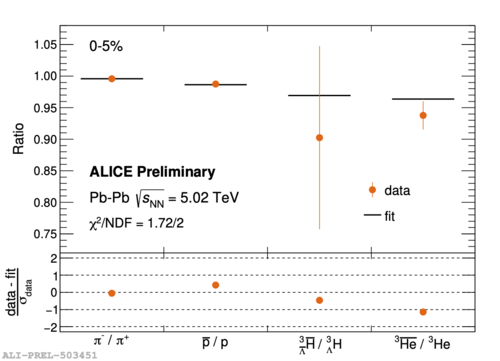
Antiparticle-to-particle ratios in Pb-Pb collisions (three centrality classes shown). The fits with the black lines are used to estimate the baryochemical potential of the system.
Further information: http://alice-figure.web.cern.ch/node/21620
The shine from heavy-ion collisions
Photons are emitted during the entire duration of a heavy-ion collision. Prompt direct photons are produced in initial hard-parton scatterings, prior to the formation of the quark-gluon plasma (QGP), and dominate the photon spectrum at large values of the transverse momentum (pT). Because photons do not have a colour charge and thus do not interact with the QGP, their yield, well described by perturbative quantum chromodynamics (pQCD), directly reflects the rate of initial hard-scattering processes. Thermal direct photons are, instead, produced in the QGP and in the subsequent hot hadron gas. They are expected to give a significant contribution at low pT with a spectrum that falls off exponentially with pT. This is similar to the thermal radiation from a red-hot heating element, or the surface of the Sun. However, in heavy-ion collisions, the thermal photon spectrum is an effective average over the different volume elements in the QGP and the hadron gas at different temperatures. ALICE has previously reported the photon spectrum from Pb-Pb collisions collected in the LHC Run 1, which allowed us to infer an effective temperature of about 300 MeV. A new preliminary analysis of LHC Run 2 data at increased centre-of-mass energy of 5.02 TeV per nucleon-nucleon collision is presented for the first time at the conference. The photon spectrum is described well by calculations that include prompt pQCD photons from hard scatterings and thermal photons. These calculations suggest a dominance of thermal photons at pT<3 GeV/c. The analysis will be extended to the full data sample collected in Run 2 with the goal of estimating the effective temperature of the photons that shine from these collisions.
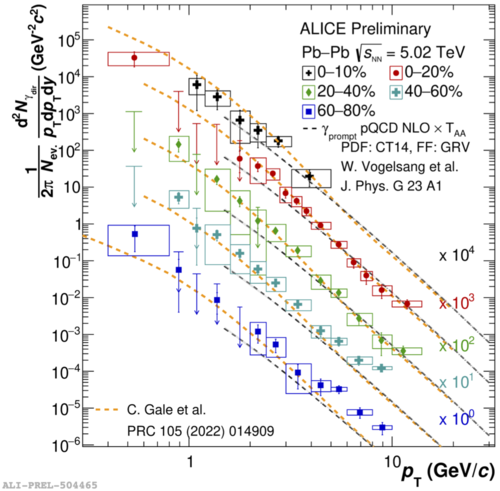
Production yields of direct photons in Pb-Pb collisions with decreasing centrality from top to bottom, compared to calculations that include prompt photons from hard scatterings and thermal direct photons.
Further information: http://alice-figure.web.cern.ch/node/21776
Beyond the average: higher moments of the antideuteron multiplicity distribution
Despite two decades of extensive studies, the production of antinuclei in heavy-ion collisions is not fully understood. Conceptually-different theoretical models give very similar predictions for the production yields of, for example, deuteron antinuclei (bound states of an antiproton and an antineutron). This calls for new experimental observables that can discern among production models. The first measurement of event-by-event antideuteron number fluctuations in high-energy heavy-ion collisions is reported in a new ALICE article. The results are compared with existing coalescence calculations, which fail to describe the measurement. Thermal-statistical model calculations describe the measurements only for correlation volumes that are different with respect to those describing proton yields and a similar measurement of net-proton number fluctuations. The results present a severe challenge to the current understanding of nuclei production in heavy-ion collisions at the LHC energies.
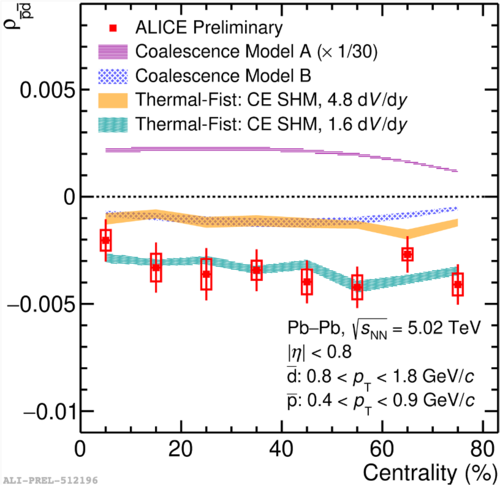
Pearson correlation coefficient between antiprotons and antideuterons as a function of centrality in Pb-Pb collisions. The collisions in which at least one antideuteron is present show a smaller number of antiprotons.
Further reading: ALICE-PUBLIC-2022-012 https://cds.cern.ch/record/2805493
Accessing the residual strong force between charm and non-charm hadrons
Besides gravitation, electromagnetism, and the weak force, the strong force is one of the four fundamental forces of nature. It acts between quarks and binds them together in hadrons such as protons and neutrons. The residual force that attracts quarks of two separate hadrons is responsible for the binding of protons and neutrons to larger nuclei. While this residual strong force is well studied for hadrons that consist of up, down, and strange quarks, it has never been measured for those containing charm quarks. In ALICE, a special two-particle correlation technique called femtoscopy has been employed, which allows one to probe its strength. By looking at the distribution of the relative momentum difference of charged D meson (a charm quark bound to a down antiquark) and protons (two up quarks and one down quark), we can investigate if these particles rather attract each other or repel. While this force is strongly attractive between protons and neutrons, we have hints that D mesons are repelled from pions and attracted to protons

Two-particle correlation function of D mesons with pions, compared to the expected Coulomb interaction and a fit that includes the residual strong interaction.
Further reading: arXiv:2201.05352, http://alice-figure.web.cern.ch/node/22039
Small but flowing: hadron-dependent anisotropy in pp and p-Pb collisions
The plasma of quark and gluons (QGP) formed in ultra-relativistic collisions of heavy nuclei behaves as an almost perfect liquid. The hydrodynamic nature of the QGP medium results in the observed flow of the produced particles. There are two types of particle flow, the radial flow and the anisotropic flow. The radial flow is related to the common velocity field of the expanding QGP. The pressure gradients inside QGP transform the spatial anisotropies of the overlap area of the colliding nuclei into anisotropic flow. At low particle momenta, the anisotropic flow shows a characteristic particle-mass ordering. At higher momenta, the baryon particles composed of three quarks have roughly 50% higher flow with respect to the meson particles composed of quark-antiquark. This indicates that the flow arises already at the level of quarks, usually referred to as partonic flow, and that the hadron production at higher momenta is dominated by a quark coalescence.
Although initially unexpected, the particle flow has been also observed in small collision systems like proton-proton and proton-lead. Its origin is not yet fully clarified. Recent precise flow measurements of various hadron species by ALICE clearly indicate mass ordering at low momenta and baryon-meson splitting at higher momenta, thus bringing more similarities between the flow patterns measured in small and large collision systems.
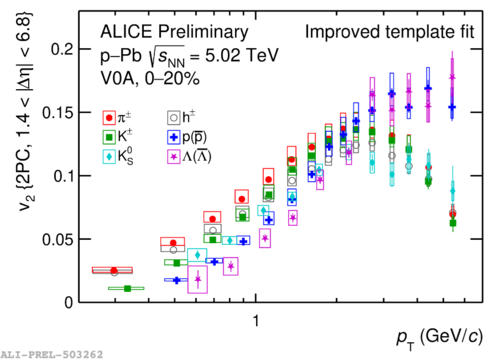
Second-harmonic anisotropic flow as a function of transverse momentum for various hadron species in proton-lead collisions.
Further information: http://alice-figure.web.cern.ch/node/21589
ALICE gears up for Run 3 at the LHC
The ALICE detector has undergone a major upgrade during the LHC long shutdown 2. New inner trackers, instrumented with monolithic active pixel detectors with a spatial resolution of about 5 microns, were installed in the central-rapidity barrel and forward muon-spectrometer acceptances. The new GEM-based readout planes of the time projection chamber, the new fast trigger detector, the readout upgrade of several other detector components, and an integrated online-offline processing system, will enable recording Pb-Pb collisions at an interaction rate of up to 50 kHz. The upgraded apparatus was commissioned with cosmic-ray muons and, in October 2021, with a proton-proton pilot run at the centre-of-mass energy of 900 GeV. A number of benchmark analyses of the new data were carried out in order to fully validate the new hardware, online and offline processing software, as well as a redesigned analysis framework that meets the larger data-throughput requirements of Run 3. The benchmark analyses included measurement of the charged-particle multiplicity distribution as a function of pseudorapidity, the momentum and angular correlations functions of charged particles and identified protons, as well as the reconstruction of strange hadron weak decays. ALICE is ready to start Run 3 with pp data-taking in summer and the lead-lead in November 2022!
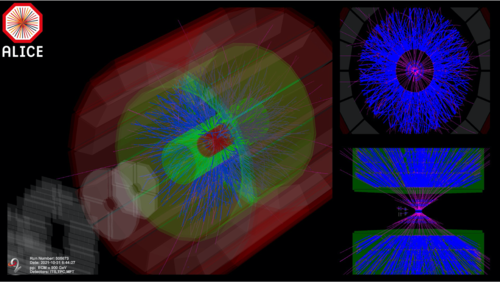
ALICE event display of proton-proton collisions from the pilot LHC beam in October 2021.

Analysis of the pilot beam data: charged-particle multiplicity compared to a measured with 2010 data; two-particle yield angular correlations; momentum correlation of identified proton pairs; invariant mass distribution of strange baryon decay candidates.
